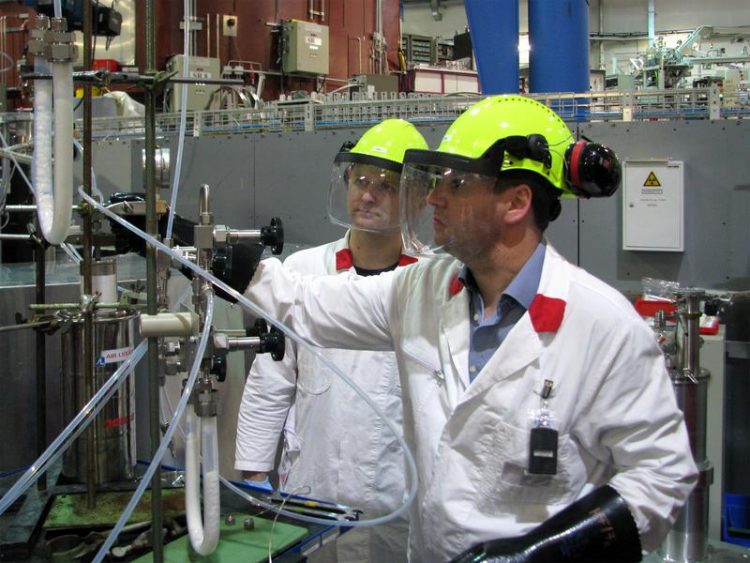Investigations with neutrons settle scientific dispute about the structure of fluorine

Prof. Florian Kraus and his colleague Dr. Sergei Ivlev at the powder diffractometer SPODI Image: M. Hölzel / TUM
Fluorine is the most reactive chemical element and highly toxic. It is nonetheless widely deployed. In the first attempt to determine the atomic distances of solid fluorine in 1968, a research team in the United States used X-rays. A difficult task, because fluorine only becomes solid at about minus 220 °C. And already cooling down the aggressive element resulted in explosions.
Nobel laureate Linus Pauling was sceptical about the results of the team and in 1970 proposed an alternative structural model – without delivering the experimental proof. For 50 years, no other chemist ventured to take on the delicate task.
Using neutrons from the Heinz Maier-Leibnitz Research Neutron Source in Garching, scientists from the University of Marburg, the Technical University of Munich (TUM) and the Aalto University in Finland have now finally elucidated the structure.
Neutrons – the ideal probes
Neutrons are particularly well suited for localizing fluorine atoms with high precision. Since they can penetrate even thick-walled sample containers, neutrons provided the method of choice for Professor Florian Kraus and his team in Marburg. They were supported in their investigations on the powder diffractometer SPODI at the FRM II by the TUM scientist Dr. Markus Hölzel and his colleagues.
For their investigations, the researchers implemented a special measuring setup to study fluorine at very low temperatures. To this end, they deployed materials that are particularly resistant to fluorine and ensure safe handling.
Application in LEDs, toothpaste and pharmaceuticals
“Extremely precise measurements with neutrons are important to facilitate calculations for a wide variety of applications,” says Florian Kraus. “For other elements, high-precision crystal structures have been available for years. The crystal structure of oxygen, for example, has been investigated 35 times and carbon even 108 times.”
But fluorine is also an essential part of everyday life. Among other things, fluorides are used as additives to toothpaste. They are used in LED bulbs to turn the cold LED light into a warm white. Fluorine compounds are also added to many pharmaceuticals to increase their effectiveness.
Neutron measurements confirm the suspicions of the Nobel Prize winner
Even though the results of the measurements from the 1960s were not precise, Florian Kraus was nonetheless quite surprised by the great difference: “Using neutron measurements, we were able to resolve the atomic distance 70 percent more accurately,” says the chemist. “And the crystal structure shows that Nobel laureate Linus Pauling was spot on with his doubts.”
Additional Information:
The work was funded by the German Research Foundation and the German Academic Exchange Service. The neutron diffractometric measurements were carried out on the SPODI powder diffractometer of the Heinz Maier Leibnitz Research Neutron Source. Theoretical calculations were carried out at the Finnish IT Center for Science (CSC).
Dr. Markus Hölzel
Instrument scientist SPODI
Research-Neutronsource Heinz Maier-Leibnitz (FRM II)
Technical University of Munich
Lichtenbergstr. 1, 85748 Garching, Germany
Tel.: +49 89 289 14314 – E-mail: markus.hoelzel@frm2.tum.de
Prof. Dr. Florian Kraus
Inorganic Chemistry – Fluorine Chemistry
Philipps-Universität Marburg
Hans-Meerwein-Straße 4, 35032 Marburg, Germany
Tel.: +49 6421 282 6668 – E-mail: f.kraus@uni-marburg.de
The Crystal Structures of alpha- and beta-F2 revisited
Sergei I. Ivlev, Antti J. Karttunen, Markus Hoelzel, Matthias Conrad, Florian Kraus
Chemistry – A European Journal, 10.1002/chem.201805298;
LINK: http://dx.doi.org/10.1002/chem.201805298
https://www.tum.de/nc/en/about-tum/news/press-releases/detail/article/35306/ Link to the press release
Media Contact
All latest news from the category: Life Sciences and Chemistry
Articles and reports from the Life Sciences and chemistry area deal with applied and basic research into modern biology, chemistry and human medicine.
Valuable information can be found on a range of life sciences fields including bacteriology, biochemistry, bionics, bioinformatics, biophysics, biotechnology, genetics, geobotany, human biology, marine biology, microbiology, molecular biology, cellular biology, zoology, bioinorganic chemistry, microchemistry and environmental chemistry.
Newest articles

Superradiant atoms could push the boundaries of how precisely time can be measured
Superradiant atoms can help us measure time more precisely than ever. In a new study, researchers from the University of Copenhagen present a new method for measuring the time interval,…

Ion thermoelectric conversion devices for near room temperature
The electrode sheet of the thermoelectric device consists of ionic hydrogel, which is sandwiched between the electrodes to form, and the Prussian blue on the electrode undergoes a redox reaction…

Zap Energy achieves 37-million-degree temperatures in a compact device
New publication reports record electron temperatures for a small-scale, sheared-flow-stabilized Z-pinch fusion device. In the nine decades since humans first produced fusion reactions, only a few fusion technologies have demonstrated…





















